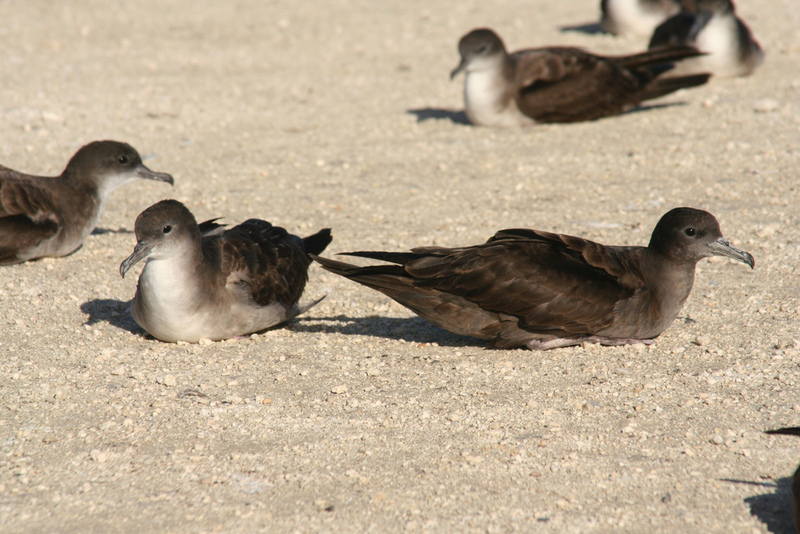Wedge-tailed Shearwater (Puffinus pacificus) - Wiki Wedge-tailed Shearwater
From Wikipedia, the free encyclopedia
Order: Procellariiformes
Family: Procellariidae
Synonyms: Procellaria pacifica Gmelin, 1789
[Photo] Wedge-tailed Shearwater Puffinus pacificus colour morphs, pale on left, dark on right. Tern Island, Northwest Hawaiin Islands. Date 2006. Author: Duncan Wright (http://commons.wikimedia.org/wiki/User:Sabine%27s_Sunbird).
The Wedge-tailed Shearwater, Puffinus pacificus is a medium-large shearwater in the seabird family Procellariidae. It is one of the shearwater species that is sometimes referred to as a Muttonbird, like the Sooty Shearwater of New Zealand and the Short-tailed Shearwater of Australia. It ranges across from throughout the tropical Pacific and Indian Ocean roughly between latitudes 35°N and 35°S. It breeds in islands such as off Japan, the Islas Revillagigedo, the Hawaiian Islands, the Seychelles and off Western Australia.
Description
The Wedge-tailed Shearwater is the largest of the tropical shearwaters. There are two colour morphs of the species, dark and pale; the pale morphs predominate in the North Pacific, the dark morph elsewhere. However, both morphs exist in all populations, and bear no relation to sex or breeding condition. The pale morph has grey-brown plumage on the back, head and upperwing, and whiter plumage below. The darker morph has the same dark grey-brown plumage over the whole body. The species’ common name is derived from the large wedge-shaped tail, which may help the species glide. The bill is dark and legs are flesh coloured, with the legs set far back on the body (in common with the other shearwaters) as an adaptation for swimming.
This species is related to the pan-Pacific Buller's Shearwater, which differs much in color pattern, but also has a wedgetail and a thin black bill (Austin, 1996; Austin et al, 2004). They make up the Thyellodroma group, a superspecies in the large shearwaters of the proposed genus Ardenna (Penhallurick & Wink, 2004).
Diet
Wedge-tailed Shearwaters feed pelagically on fish, squid and crustaceans. 66% of their diet is fish, of which the most commonly taken is goatfish. It was thought that the species mostly took food from surface feeding, observations of feeding Wedge-tails suggested that contact-dipping, where birds flying close to the surface snatch prey from the water was the most commonly used hunting technique. However, a 2001 study which deployed maximum depth recorders found that 83% of Wedge-tails dived during foraging trips with a mean maximum depth of 14 m and that they could achieve a depth of 66 m (Burger, 2001).
Breeding behaviour
The Wedge-tailed Shearwater breeds in colonies on small tropical islands. Breeding seasons vary depending on location, with synchronised breeding seasons more common at higher latitudes. Northern hemisphere birds begin breeding around February, southern hemisphere birds begin around September. Wedge-tailed Shearwaters display natal philopatry, returning to their natal colony to begin breeding at the age of four.
Wedge-tailed Shearwaters are monogamous, forming a long term pair bond that lasts for several years. Divorce between pairs occurs after breeding seasons that end in failure. Nesting either in burrows or sometimes on the surface under cover. Pairs call frequently as a pair, both to reinforce the pair bond and warn intruders away from their territory. Parents also call to their chicks. The call is long, with an inhaling component (OOO) and exhaling component (err); their Hawaiian name ua’u kani means moaning petrel. Both sexes participate in digging a burrow, or repairing the burrow from last year. Nesting burrows of other species are also used. The breeding season of the Bonin Petrel in Hawaii is timed to avoid that of the Wedge-tail; in years where Bonin Petrel chicks are still in burrows when Wedge-tails return to begin breeding these chicks are killed or evicted. It attends these colonies nocturnally, although non-breeding Wedge-tails are often seen at the surface throughout the day and breeding birds will rest outside their burrows before laying.
Both sexes undertake a prelaying exodus in order to build up energy reserves, this usually lasts around 28 days. A single egg is laid, if that egg is lost then the pair will not attempt another that season. After laying the male usually undertakes the first incubation stint. Both sexes incubate the egg, in stints that can last up to 13 days. Incubation takes around 50 days. After hatching the chick is brooded for up to six days, until it is able to thermoregulate, after which it is left alone in the nest while both parents hunt for food. It is initially fed with stomach oil, an energy rich waxy oil of digested prey created in the parent’s gut; later it is fed both solids and stomach oil. Unlike many procellariids Wedge-tailed Shearwater parents to not alternate long and short trips to provide food, but return regularly. Chicks increase in size to 560 g (larger than the adults) then drop to around 430 g before fledging. Fledging occurs after 103-115 days, after which the chick is independent of the adult.
Known breeding colonies include:
Heron Island, Australia
Lord Howe Island, Australia
Montague Island, Southern New South Wales, Australia
Muttonbird Island, Coffs Harbour, Northern New South Wales, Australia
Manana Island, Hawaii, USA
http://en.wikipedia.org/wiki/Wedge-tailed_Shearwater
| The text in this page is based on the copyrighted Wikipedia article shown in above URL. It is used under the GNU Free Documentation License. You may redistribute it, verbatim or modified, providing that you comply with the terms of the GFDL. |
